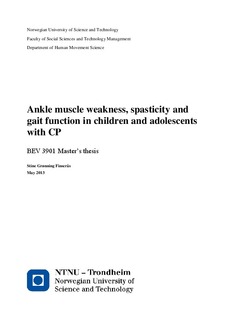| dc.description.abstract | Aim: The overall purpose of this study was to investigate whether ankle strength and spasticity measures evaluated by a dynamometer can detect the body function impairments important for gait function represented by gait speed, step length and phase of single support.
Methods: 12 children and adolescents with unilateral and bilateral spastic cerebral palsy were included in the study. All participants went through a 3D gait analysis to evaluate temporal spatial variables (gait speed, step length and phase of single support). To measure ankle strength and spasticity, the subjects performed plantarflexion and dorsiflexion in passive, concentric and isometric condition in a Biodex dynamometer. Both sessions included simultaneous surface electromyography recordings on mm. gastrocnemius medialis, soleus and tibialis anterior.
Results: Concentric and isometric weakness and impaired rate of torque development in the affected ankle was detected. Spasticity in the ankle was likely not detected in the dynamometer, as the muscle activity during passive stretch in the affected foot was not significantly different from the contralateral foot. The phase of single support was statistical significant lower in the affected foot than the contralateral foot, while step length was not different between the affected and the contralateral foot. There were some significant correlations between ankle strength and muscle activation during passive stretch, as well as between muscle activity during passive stretch and gait function. There were no significant correlations between ankle strength and gait function.
Conclusion: The dynamometer along with EMG recordings did likely provide a valid measurement for ankle strength, but not for ankle spasticity. Ankle weakness did not interfere with gait function in these subjects, while ankle muscle activity during passive stretch showed stronger relationships to gait function.
Keywords: Cerebral palsy, ankle, muscle weakness, spasticity, gait function, electromyography | nb_NO |
